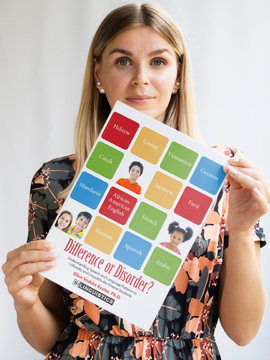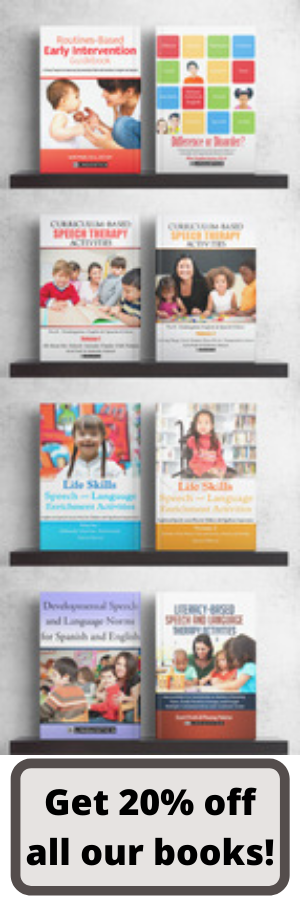Certificate in Cultural & Linguistic Diversity
$59.00

16 Hours of ASHA CEUs!
Become highly competent in serving and reducing your caseload and become a leader in your professional community.
- Improve your confidence in diagnosing any child.
- Identify the difference between disorder and second-language influence
- Effectively evaluate students from second-language backgrounds
Improve your students’ success in therapy
- Successfully treat all types of speech sound disorders
- Reduce therapy planning with literacy-based intervention
- Increase student interest with culturally rich therapy
Improve your professional interactions
- Collaborate with teachers to improve the referral process
- Increase parent involvement
- Effectively evaluate students from second-language backgrounds
- Ethically reconcile difficult situations
This series of 10 online presentations is packed with downloadable therapy materials, goal banks, charts of developmental norms, and parent/teacher resources!
ASHA Course Code: Diversity, Equity, and Inclusion in Education, Training, Service Delivery, Public Policy – 7030
| Credit | 1.6 Continuing Education Units |
|---|---|
| Duration | 16 hours |
| Topics | Diversity, Equity, & Inclusion (DEI), Ethics, Evaluations |
| Format | Video |

FINANCIAL: Phuong Lien Palafox, M.S., CCC-SLP was employed by Bilinguistics. Bilinguistics receives royalty payments for resources and online courses. Non-Financial Disclosure: Phuong Lien Palafox does not have any non-financial relationships to disclose.
Financial Disclosure: Ellen Kester, Ph.D., CCC-SLP. Dr. Ellen Kester is the owner of Bilinguistics and receives a salary. Bilinguistics receives royalty payments for online courses. Non-Financial Disclosure: Ellen Kester does not have any non-financial relationships to disclose.
Financial Disclosure: Scott Prath, M.A., CCC-SLP is a salaried employee of Bilinguistics. Bilinguistics receives royalty payments for online courses. Non-Financial Disclosure: Scott Prath does not have any non-financial relationships to disclose.
Financial Disclosure: Mary Bauman, M.A., CCC-SLP was an employee of Bilinguistics. Bilinguistics receives royalty payments for online courses. Non-Financial Disclosure: Mary Bauman does not have any non-financial relationships to disclose.
Financial Disclosure: Marie Wirka, M.S., CCC-SLP was an employee of Bilinguistics. Bilinguistics receives royalty payments for online courses. Non-Financial Disclosure: Marie Wirka does not have any non-financial relationships to disclose.
Your professional success and happiness are dependent on your ability to identify how to help children communicate better and then move them through their goals.
But what if they speak a second-language at home? Are they hard to understand or having difficulty in the classroom because of the second language? What sounds are difficult to produce because of the second language? Cultural and linguistic competency will make your therapy soar and will put the right children on your caseload.
What does it mean to be culturally and linguistically competent?
Does it mean that you speak two languages? No. Does it mean that you share the culture of the children you work with? No. Cultural competence means that you take into account cultural and linguistic diversity when diagnosing and treating communication disorders.
The diversity of cultures and languages that we encounter in our profession is great. Our confidence in serving this population can be dramatically increased by targeting culture, evaluation, and intervention in a very specific way. Through these modules on cultural and linguistic competence, Bilinguistics offers the breadth of bilingual knowledge that has allowed us to serve multicultural communities, train graduate students, conduct research, and provide professional support for our colleagues since 2002.
How Does this Course Meet ASHA’s Competencies?
The courses in this series have been produced in concert with the American Speech-Language Hearing Association’s cultural competencies.
“Only by providing culturally and linguistically appropriate services can we provide the quality of services our clients/patients deserve. Regardless of our personal culture, practice setting, or caseload demographics, we must strive for culturally and linguistically appropriate service delivery.” ASHA’s Multicultural Issues Board
Bilingualism 101 Components
Difference vs. Disorder – Speech Development
1.5 hour
Have you ever wondered whether certain articulation errors that a bilingual child produces should be counted as incorrect? The sound systems of a bilingual child’s two languages interact in predictable ways. Using Spanish and English as an example, this course provides a framework for identifying “errors” that are typical and those that are atypical.
Difference vs. Disorder – Language Development
2 hours
You want to take this course? Did you know that in Spanish you don’t need to add a word at the beginning of the sentence to make it a question? When Spanish speakers are learning English, they often use Spanish rules for making sentences in English. This course helps SLPs differentiate typical and atypical language patterns.
Working with Interpreters
2.5 hours
Working with interpreters is becoming more common and is often a necessity when providing services to culturally and linguistically diverse populations. Gain important skills needed to train qualified interpreters. Skills include appropriate vocabulary and cultural considerations necessary for effective communication with parents regarding disabilities, services, and rights.
Ethical Considerations
2 hours
Successfully navigate contentious situations when confronted with an ethical dilemma. Learn about the origin of ethics, how professions address ethical issues, and dissect intriguing case studies supplied by speech pathologists. Have you ever had an ethical question or dilemma arise? Or, do you work with clients who speak a language other than English and have concerns about how ethical the services are that they receive? This presentation shares the ASHA Code of Ethics and how it relates to working with multicultural populations. The presentation concludes with numerous case studies from SLPs in the field.
School-Age Components
Collaborating with Teachers to make great referrals
1.5 hours
Evaluations are a major chunk of our week in the schools and evaluating students who do not qualify for services exacerbates the situation. Yes, Response to Intervention has minimized some unnecessary referrals but teachers continue to struggle with classroom interventions and the referral process. The simple and useful tools provided in this presentation can help reduce your workload, decrease unnecessary referrals, and increase the support for your campus.
Evaluating Students from Diverse Populations
1.5 hours
Do I really have to test in both languages? Yes, and we’ll tell you why. We’ll also give you tools for interpreting scores when your student is not well represented in the test norms. We’ll provide you with great information about language samples, norms, and other informal testing procedures that will make you feel confident about your diagnostic decisions for your bilingual students. Our case studies will provide you with hands-on experience.
Language Intervention Strategies for Monolingual and Bilingual Children
1.5 hours
Do you have to pick a single language for therapy? Therapy programs should mimic your student’s classroom environment so that new skills can be generalized across the academic day. If both English and Spanish are used in the classroom, we’ll help you pick goals that are appropriate for both languages so that you can provide the most efficient treatment possible.
Success with Speech Sound Disorders
1.5 hours
Why don’t my speech tricks work equally with all of my speech students? This course provides a framework for better classification of speech disorders. Research has shown a benefit to using different therapy techniques for different speech disorders. We’ll arm you with ways to better define your students and give you intervention strategies to best match their specific deficit.
Early Childhood Components
Effectively Evaluating Young Children
1 hour
Many Early Childhood Intervention programs across the states have a set group of evaluation tools that are approved for evaluation. The problem is that many of them are not great for the area of speech and language, and most of them do not consider other languages. In this course we dissect a number of the tools used in the birth-to-three population and show you what types of items to look out for. We’ll equip you with great information to build your clinical judgment with children from homes where a language other than English is spoken.
Increasing Parent and Teacher Involvement
1 hour
What’s the best way to make quick progress in therapy? Get parents on board. Practice makes perfect, right? If we are going to be successful at helping children achieve their speech and language goals quickly, we need to make sure that they are practicing a lot. In this course we talk about research on parent involvement, including the benefits of it, the barriers to strong involvement, and ways to improve it.
Effectively treating and evaluating multicultural populations has a dramatic impact on solving some of the greatest current needs of our field: caseload size, over-identification, and budget and staff shortfalls. This series of 10 online presentations included therapy materials, goal banks, charts of developmental norms and parent/teacher resources.
Difference vs. Disorder – Speech Development
Participants will:
Understand typical speech development for bilinguals
Identify typical speech processes of bilinguals
List similarities in typical monolingual and bilingual speech development
Identify speech intervention goals for bilingual children
Difference vs. Disorder – Language Development
Participants will:
Understand the need for all SLPs to have CLD training
Describe a framework for categorizing difference and disorder
List three types of errors that children learning two languages can make
Identify similarities and differences in typical monolingual and bilingual language development
Understand developmental errors, cross-linguistic errors, and atypical errors
Describe language structures that are subject to second language influence in second language learners
Working with Interpreters
Participants will:
Describe procedures for working and collaborating with interpreters during speech and language assessment, treatment and speaking with parents in ARD/IEP meetings.
Describe cultural issues when working with students and families from other cultures, with emphasis on the bilingual Spanish-English population
Use or inform interpreters of appropriate vocabulary and scripts in Spanish that are culturally sensitive to explain the ARD/IEP paperwork and processes to parents
Ethical Considerations
Participants will:
List laws and codes of ethics pertaining to speech language pathologists
Describe legal issues that relate to serving a bilingual population
Discuss ethical issues related to working with culturally and linguistically diverse populations through use of case studies
Identify sections of the Codes of Ethics that assist in decision-making for case studies
Effectively Evaluating Young Children
Participants will:
Describe formal and informal measures for testing ELLs
Use tests when a student is not represented in the normative sample
Discuss ASHA guidelines for assessment with bilingual students
Identify red flags for speech and language impairment in bilingual children.
Identify sounds on the Goldman-Fristoe that are subject to second language influence
Increasing Parent and Teacher Involvement
Participants will:
Understand the importance of family involvement
List the factors affecting parent involvement
Discuss theoretical models of social systems
Use strategies to increase family involvement in intervention
Collaborating with teachers to make great referrals
Participants will:
View RTI from a broad perspective
Introduce a macro approach to looking at the results of RTI and further driving accurate assessment
Evaluate the make-up of students in special education
Show how RTI can reduce caseload work, better identify students, and reduce special education spending
Evaluating Students from Diverse Populations
Participants will:
List reasons for testing both languages
Describe formal and informal measures for testing ELLs
Use tests when a student is not represented in the normative sample
Discuss ASHA guidelines for assessment with bilingual students
Identify red flags for speech and language impairment in bilingual children.
Identify sounds on the Goldman-Fristoe that are subject to second language influence
Language Intervention Strategies for Monolingual and Bilingual Children
Participants will:
Understand the cognitive process for acquiring language abilities and new vocabulary
Discuss therapy plans that effectively serve children from second-language backgrounds
List cultural and socio-economic issues that can affect therapeutic outcomes
Identify language intervention goals for bilingual children
Success with Speech Sound Disorders
Participants will:
List subgroups of speech sound disorders
Describe differences in articulatory and phonological development and error patterns in Spanish and English
Discuss existing therapy approaches and programs for addressing speech sound disorders
Understand which strategies are most appropriate for a child, depending on his/her types of errors
Time-Ordered Agenda
05 minutes – Introduction
1.5 hours – Course: Difference vs. Disorder: Speech Development
2.0 hour – Course: Difference vs. Disorder: Language Development
2.5 hours – Course: Working with Interpreters
2.0 hours – Course: Ethical Considerations with CLD Populations
1.0 hour – Course: Evaluation of Young Children from Second Language Backgrounds
1.0 hour – Course: Increasing Parent & Teacher Involvement
1.5 hours – Course: Collaborating with Teachers to Make Great Referrals
1.5 hours – Course: Evaluating Students from Second Language Backgrounds
1.5 hours – Course: Language Intervention Strategies for Monolingual and Bilingual Children
1.5 hours – Course: Success with Speech Sound Disorders
05 minutes – Course quiz and evaluation
Need CEUs?

 Share
Share
 Tweet
Tweet
 LinkedIn
LinkedIn
 Pin
Pin
 Email
Email









